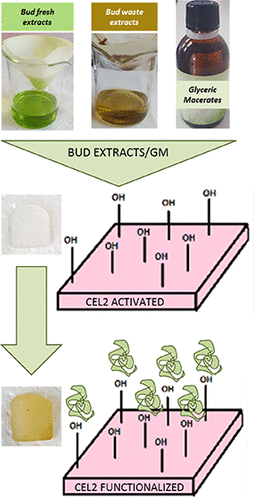当前位置:
X-MOL 学术
›
ACS Biomater. Sci. Eng.
›
论文详情
Our official English website, www.x-mol.net, welcomes your
feedback! (Note: you will need to create a separate account there.)
Surface Functionalization of a Silica-Based Bioactive Glass with Compounds from Rosa canina Bud Extracts
ACS Biomaterials Science & Engineering ( IF 5.4 ) Pub Date : 2020-12-11 , DOI: 10.1021/acsbiomaterials.0c01170 Giulia Ferlenda 1 , Martina Cazzola 1 , Sara Ferraris 1 , Andrea Cochis 2 , Ajay Kumar 2 , Enrico Prenesti 3 , Silvia Spriano 1 , Enrica Vernè 1
ACS Biomaterials Science & Engineering ( IF 5.4 ) Pub Date : 2020-12-11 , DOI: 10.1021/acsbiomaterials.0c01170 Giulia Ferlenda 1 , Martina Cazzola 1 , Sara Ferraris 1 , Andrea Cochis 2 , Ajay Kumar 2 , Enrico Prenesti 3 , Silvia Spriano 1 , Enrica Vernè 1
Affiliation

|
Bud extracts are a new category of vegetal products, which are used in gemmotherapy. These products are liquid preparation sources of bioactive molecules (phytochemicals) and are used in medicine as health-promoting agents. Rosa canina is a medicinal plant belonging to the family Rosaceae. The R. canina bud extracts, in particular, possess anti-inflammatory and antioxidant activities due to the presence of flavonoids and other phenolic compounds. The combination of R. canina bud extracts with biomaterials can be promising for obtaining multifunctional materials carrying both inorganic and biological properties. In this work, a protocol of functionalization has been properly designed, for the first time in the literature, in order to graft various bud extracts of R. canina to a silica-based bioactive glass (CEL2). The Folin–Ciocalteu method was used to determine the redox capacity of total polyphenols in the extracts and on functionalized solid samples. X-ray photoelectron spectroscopy analysis and fluorescence microscopy were employed to investigate the presence of phenol substances on the material surface. Bioactivity (in terms of ability of inducing hydroxyapatite precipitation) has been investigated by soaking the samples, with or without functionalization, in simulated body fluid. The presence of the polyphenols from bud extracts not only preserved glass bioactivity but even enhanced it. In particular, the solution obtained from the byproducts of primary extraction in glycerol macerate showed the best performances. Moreover, the presence and antioxidant activity of bud extract compounds on the material surface after grafting demonstrate the possibility of combining the glass inorganic bioactivity with the biomolecule-specific properties, making possible a local action at the implant site. The promising results reported in this work pave the way for the realization of new multifunctional materials with a green approach.
中文翻译:

用犬蔷薇芽提取物中的化合物对二氧化硅基生物活性玻璃进行表面功能化
芽提取物是一类新的植物产品,用于宝石疗法。这些产品是生物活性分子(植物化学物质)的液体制剂来源,并在医学中用作健康促进剂。犬蔷薇(Rosa canina)是蔷薇科蔷薇属的药用植物。由于黄酮类化合物和其他酚类化合物的存在,犬红花芽提取物尤其具有抗炎和抗氧化活性。犬红花芽提取物与生物材料的结合有望获得具有无机和生物特性的多功能材料。在这项工作中,在文献中首次正确设计了功能化方案,以便将犬红花的各种芽提取物移植到二氧化硅基生物活性玻璃(CEL2)上。 Folin-Ciocalteu 方法用于测定提取物和功能化固体样品中总多酚的氧化还原能力。采用X射线光电子能谱分析和荧光显微镜研究了材料表面苯酚物质的存在。通过将有或没有功能化的样品浸泡在模拟体液中来研究生物活性(就诱导羟基磷灰石沉淀的能力而言)。花蕾提取物中多酚的存在不仅保留了玻璃的生物活性,甚至还增强了它。特别是,从甘油浸渍液中初级提取的副产物获得的溶液表现出最好的性能。 此外,接枝后材料表面上芽提取物化合物的存在和抗氧化活性证明了将玻璃无机生物活性与生物分子特异性特性相结合的可能性,使得在植入部位的局部作用成为可能。这项工作报告的有希望的结果为以绿色方法实现新型多功能材料铺平了道路。
更新日期:2021-01-11
中文翻译:

用犬蔷薇芽提取物中的化合物对二氧化硅基生物活性玻璃进行表面功能化
芽提取物是一类新的植物产品,用于宝石疗法。这些产品是生物活性分子(植物化学物质)的液体制剂来源,并在医学中用作健康促进剂。犬蔷薇(Rosa canina)是蔷薇科蔷薇属的药用植物。由于黄酮类化合物和其他酚类化合物的存在,犬红花芽提取物尤其具有抗炎和抗氧化活性。犬红花芽提取物与生物材料的结合有望获得具有无机和生物特性的多功能材料。在这项工作中,在文献中首次正确设计了功能化方案,以便将犬红花的各种芽提取物移植到二氧化硅基生物活性玻璃(CEL2)上。 Folin-Ciocalteu 方法用于测定提取物和功能化固体样品中总多酚的氧化还原能力。采用X射线光电子能谱分析和荧光显微镜研究了材料表面苯酚物质的存在。通过将有或没有功能化的样品浸泡在模拟体液中来研究生物活性(就诱导羟基磷灰石沉淀的能力而言)。花蕾提取物中多酚的存在不仅保留了玻璃的生物活性,甚至还增强了它。特别是,从甘油浸渍液中初级提取的副产物获得的溶液表现出最好的性能。 此外,接枝后材料表面上芽提取物化合物的存在和抗氧化活性证明了将玻璃无机生物活性与生物分子特异性特性相结合的可能性,使得在植入部位的局部作用成为可能。这项工作报告的有希望的结果为以绿色方法实现新型多功能材料铺平了道路。











































 京公网安备 11010802027423号
京公网安备 11010802027423号